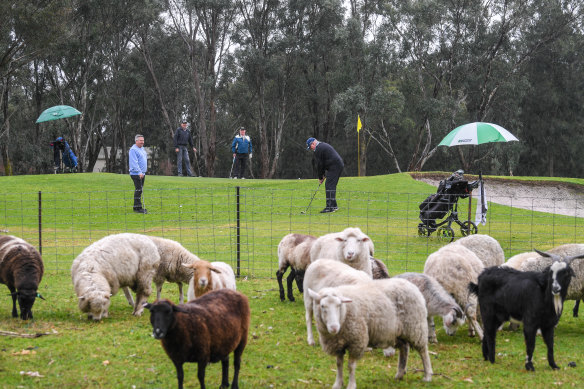A flock of sheep, alpacas, ponies, goats and a whole host of microbes don’t usually make their home on a suburban golf course. But then the Eastern Sward Golf Club, in Bangholme in Melbourne’s south, is not your usual course.
Over the past three years Eastern Sward, which was founded 50 years ago on land owned by Melbourne Water, has undertaken a novel ecological experiment, which backers say could have profound implications for clubs across Australia, as well as parks and gardens.

A group of sheep at the Eastern Sward Golf Club golf. The club is hoping to eventually stop the use of pesticides and fertilizers on the green, and will use manure and microbes to nourish the soil instead. Credit:Justin McManus
Golf courses are engineered sites, with the greens and tees usually built using sand. Because of this, they are heavily reliant on synthetic pesticides, fertilizers and fungicides to keep the grass pristine, and this comes at an environmental cost. Because courses require heavy watering, these chemicals run off into the storm water system.
But at Eastern Sward, microbes are king, explains project co-ordinator Garth Cusick. “The intent is to eliminate artificial chemicals and replace them with microbes that live within the root system of the plant,” Cusick says. “We don’t know if it will work – no one has ever done it. Our golf course is the test for the industry, to see if it’s possible.”
After coaching golf for 30 years, Cusick was hired five years ago as a consultant at Eastern Sward to decrease its expenditure and increase cash flow, in a push to set up the nine-hole course for the future.
He certainly didn’t expect to become a passionate student of microbiology, but he was encouraged to explore alternative methods of soil management, and undertook a course with US-based Soil Food Web, which champions an approach to soil health created by soil biologist Dr Elaine Ingham.
Cusick introduced a flock of ruminant animals to maintain the non-play areas of the golf course (about 10 hectares out of the total 23 hectares). The animals came from the Strong Hearts Animal Sanctuary, which rehomes animals surrendered by farms. The club started small, with four goats. It now runs 160 animals – sheep, goats, alpacas, ponies and cows – at the height of the growing season.
It now costs the club nothing to maintain these 10 hectares, but that’s not the only reason the animals are used, Cusick explains.